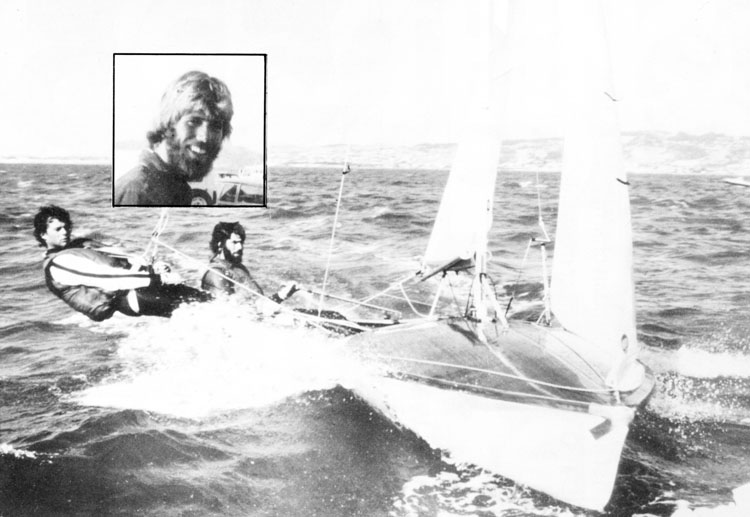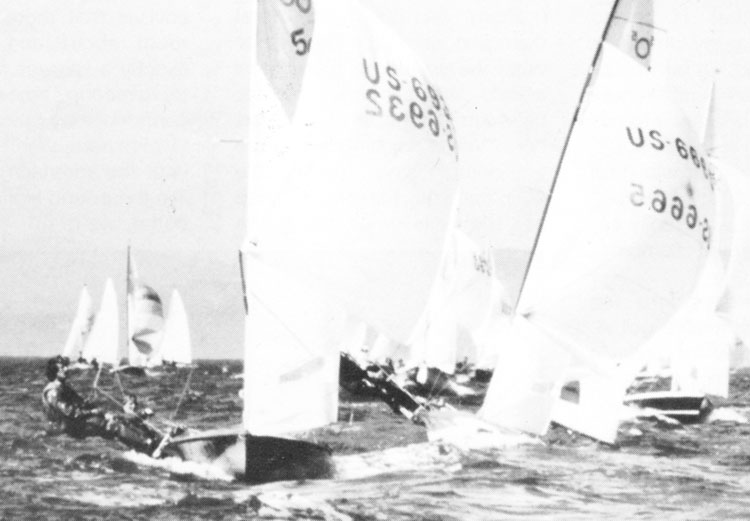|
505 WORLDS
►Overall Results |
 |
Dave White reports on the 505
world's championship in San Francisco and the continuing American
dominance.
Alastair Black took the main photo.
The 26th world championship regattas were sponsored by the St Francis
Yacht Club and the combined fleets of San Francisco Bay between 3 and 15
October. The St Francis Yacht Club is close by the Golden Gate bridge on
the southern bank of San Francisco Bay. To get to the course area
competitors could elect to sail or be towed the eight miles past
Alcatraz island to the Berkeley shore.
The course area, known as the Berkeley Circle, is an area of fairly
shallow water with very little current flow. On most days the first of
the sea breeze would reach the circle by about noon and by 1300 it would
be fairly settled in strength and direction so that races could be
started on schedule. The wind was invariably in the western quarter and
some days it was accompanied by a short chop. When the wind did shift it
tended to shift over the whole course area rather than locally.
Therefore it usually paid to go to one corner or the other. Mostly it
paid to go right, but sometimes it paid to go left and there was no
telling which was going to be best. On the runs the same tactics of
going to the corners paid off against running square. It definitely did
not pay to go up the middle, because although it was possible to make
gains against those boats that chose the wrong corner, it seemed that
the majority of the fleet did invariably find the right corner.
The first two races were won in fine style by Jorgen Schonherr of
Denmark. In the first race he was squeezed at the start by Peter
Colclough and had to tack off behind probably half the fleet. This took
him to the favoured, right side of the course and he was first around
the mark and away to an unassailable lead. Americans Surtees and
Benjamin were second and third.
In the second race Schonherr made a good early start out of the gate and
crossed the majority of the fleet to get to the right and again lead the
fleet. In this race the wind was stronger than the previous day and he
was pushed hard by America's Bixby and defending champion Benjamin. The
latter had a gear failure (after the time he spends on his boat? Editor
remark) when challenging for the lead and fell back to finish 16th.
Andron who had won two races in strong winds in the Pacifics, moved up
well to finish third behind Bixby.
The third race saw a change in the pattern and the left side of the
course was best on the first leg. Bruniges of Australia led early on,
but Bixby came through on the run by gybing away and going to the
opposite corner from the leaders. The strongish winds again brought the
same boat into the leading positions. Benjamin was second and
Schonherr's third place made him an impressive series leader at the
halfway stage.
Race four was started in very light winds from an unusual direction, the
south. Those out of the gate early did best and Benjamin led from
Colclough and Dave White at the first mark. The next leg saw the wind
swing right round to the north and this turned the race into a lottery
for most of the fleet. But the decision to abandon was a bitter blow for
the leaders Benjamin, Colclough and White.
In the rerun Bixby with the giant Cam Lewis on the wire was an easy
winner in the strong force 5 winds. Benjamin did well by setting his
spinnaker on the first reach when no-one in front did. It was a
desparate measure and Benji moved up from the mid-twenties to finish
second. Larry Tuttle of the US was third.
Myuky Kai of Japan turned the form book upside down by winning the fifth
race after a previous best place of 31. A strong breeze from the left
side of the course thrust him into the lead at the first mark. Kai held
his position inspite of huge fluctuations in wind strength and Steve
Benjamin's superb effort failed by just inches on the finish line. It
was reckoned that those inches could decide the title as Bixby's third
place meant a margin of six points separated him from Benjamin with
Bixby having the better discard. Schonherr had not maintained his early
lead in these last two races, but Olympic points scoring meant that he
could win the championship by winning the last race with Bixby below
16th place and Benjamin below 10th. This meant that the Americans could
not afford to get involved with too much infighting. An added ingredient
was that Bixby had protested Benjamin unsuccessfuly for a sail change
after the five minute gun in an earlier race.
The start of the final race was dramatic indeed with the two Americans
circling around, each intent on scoring a foul against the other before
the gate boat reached them. In the event they both got away cleanly with
the ultra-aggressive Benjamin having the upper hand. Schonherr was
buried in the middle of the fleet and had lost his chance but Bixby was
hanging on to his rival's transom.
At the last mark Benji was winning the championship by one point but
Bixby gained three places on the beat to the finish while Benjamin could
only gain one. This gave Bixby and Lewis the championship by two points.
The duel for the championship in this last race tended to overshadow
what was, nevertheless, a good performance by Peter Colclough who pulled
up from eighth position at the first mark to score a fine victory.
Bixby and Lewis' performance was impressive indeed. They had come to San
Francisco weeks ahead of the rest of us. They had been sailing the
circle virtually every day and very soon this aspect of their
preparation became apparent. They convincingly won the Pacific
championship which was held over three days prior to the worlds.
Benjamin was not quite as well prepared as is evident from his gear
failure in race two.
Bixby was using a two seasons old Lindsey hull with Tuttle foils. His
jib tack was on the bow with no spinnaker shute and he had the facility
to lift his gybing board, vertically. This of course meant that he could
stop it gybing in strong winds. Bixby is a sailmaker with the Hood one
design loft at Marblehead. He set his sails on a mast of carbon fibre
and epoxy construction. It was of smaller section than conventional
masts and the weight saving was reputedly two or three pounds. His
shrouds and trapezes were located at spinnaker sheave height as is
favoured by many of the American boats. Their hounds are generally lower
than ours and this enables them to use a lot of rig tension without the
accompanying prebend.
Each day before the race Bixby and Lewis could be seen applying a
coating of polymer to the underside of their hypocritically named boat "Complex
chemicals kill". Some people were of the opinion that this would wash
off before they reached the course area. Others said that they could
still feel it on the boat at the end of the day. Perhaps it is
coincidental, but the top two boats used this trick.
Benjamin's boat was the same one which
he used in Hayling Island last year. Like Bixby he uses no shute and his
jib tack is well forward on the bow. His ability to move the shroud
attachment points on runners gives him very good rig control. He is a
brilliant sailor, very aggressive on the water but gear failure probably
cost him the worlds. Schonherr's boat was a two-seasons old Parker. He
also had no shute and the forward jib tack. His jib, which was his own
make, was one of the fullest in the fleet. And he used a Number One main
and his own design of spinnaker.
An interesting feature on this boat was the rectangular plywood and
balsa box which was used to exclude water from the centreboard case. It
slotted onto a bolt in the back of the case so that it could pivot up
out of the way of the centreboard when raised. Schonherr claimed that he
could get rid of four litres of water � a saving of 8.8 lbs (approx
4kg).
So what are the lessons to be learned from this championship? The fact
is that the Americans have made steady technical advances over the past
few years that have put them in the forefront of 505 yachting worldwide.
It has to be said that this has been achieved at no little cost but in
this regatta they had six boats in the top 10 and 10 in the top 20.
Techniques which are standard on their boats such as stuff-luff jibs and
gybing centreboards are not widely used in other fleets. For instance,
the second best nation, the Australians do not use gybing boards. Also
several of our top boats still favour fixed boards and none of us have
the cunningham control on the jib.
Our boats seem to be over simplified by comparison with what the
Americans regard as necessities by way of control systems. Their
approach to this event was more professional and the results show it.

